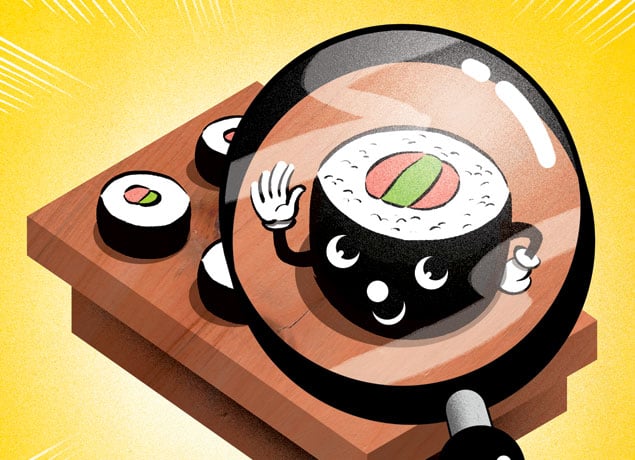Myth: Sushi is shorthand for “impeccably fresh”—and nothing is
ever frozen.
It depends on your definition of fresh. Did most seafood at a
sushi bar come in that day? No. Expect that fish has been out of water
five to nine days. The exceptions are the few places—Sushi Taro, Makoto,
and Kushi in DC, Sushi Sono in Columbia—that have some fish FedExed from
Tokyo’s Tsukiji market. Most fish is frozen at the source to kill
bacteria. Some tuna is treated to the below-zero temperatures of a
subatomic freezer.
Myth: A chef’s most important skills are sourcing and knife
work.
Those are vital, but so is the ability to preserve fish. Most
sushi restaurants get deliveries of fish Tuesdays and Fridays. The Tuesday
shipment is meant to last till Friday; the Friday haul is counted on for
the weekend. (That’s why Monday isn’t the best day to hit a sushi bar.)
The better places tend to supplement their stock with deliveries from
smaller fishmongers.
Myth: It’s all about the fish.
If you want to know what makes a great sushi restaurant, focus
on the rice. A piece of nigiri’s rice bed ought to be small and
delicate. Each grain should be distinct, firm but yielding. The flavor
should be balanced between tang from the vinegar and sweetness from the
sugar. You’ll find rice of that quality at only a few places: Sushi Taro,
Makoto, and the original Sushiko in DC’s Glover Park.
Myth: Tuna’s the prize.
Fatty varieties such as o-toro and chu-toro
are prized, but sushi purists gravitate to yellowtail, mackerel,
flounder, and others. In its earliest manifestations, sushi was made up
almost entirely of delicate white fish.
Myth: Sushi is Japanese food.
Technically, that’s true. But in Washington, there are as many
Korean-owned-and-staffed sushi restaurants as there are
Japanese-owned-and-staffed ones—and there are more Koreans here than there
are Japanese. The differences between Japanese- and Korean-style sushi?
Traditional Japanese restaurants favor restrained portions, while the
Korean style is opposite, with large pieces of fish flopping over the ends
of their rice beds.

















